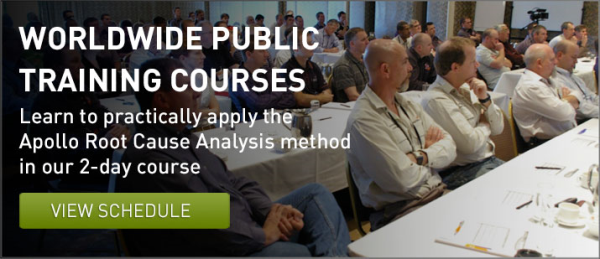By Kevin Stewart
Over the years of using the Apollo Root Cause Analysis methodology in the field, I’ve achieved a “normalization of deviance” when it comes to generating a common reality. In general, it means that I don’t always think about it or discuss it much because it is just the way things are and have been for me. So I thought I would reflect on this to remind myself how powerful a tool the Apollo Root Cause Analysis methodology is.
U nfortunately I can’t speak for other processes since the company I worked for standardized on the Apollo Root Cause Analysis methodology early on. Since it worked for us we decided to spend our time using it instead of looking for the best process. (I would be interested in others’ comments about generating a common reality utilizing other processes.) So, my comments are from a single perspective but to use an old phrase – don’t tell me it can’t work – when others are doing it! Hopefully other processes have equal success in this important aspect of RCA work.
nfortunately I can’t speak for other processes since the company I worked for standardized on the Apollo Root Cause Analysis methodology early on. Since it worked for us we decided to spend our time using it instead of looking for the best process. (I would be interested in others’ comments about generating a common reality utilizing other processes.) So, my comments are from a single perspective but to use an old phrase – don’t tell me it can’t work – when others are doing it! Hopefully other processes have equal success in this important aspect of RCA work.
In my corporate life we used to always be concerned with people who would nod their head yes to your face but internally were thinking – “it isn’t going to happen buddy”. Many times this was associated with the first line supervision since they had the direct contact with the work force and could make or break any initiative regardless of whether it came from the highest levels or not. It was very clear to me that if they saw the “WIIFM” (What’s in it for me), and agreed with it, that they could also be the biggest ally.
After many tough lessons and some personal experience, this fact became painfully obvious to me - If the supervisor recognized the value to him by believing that something would actually solve a problem that caused him pain and anguish, he was more likely to support it and even take the lead in implementing the solution. So how do we make this happen?
Most of us have heard the saying that “You support what you help to create”. Well, the Apollo Root Cause Analysis methodology helps insure this happens by creating a common reality where everyone who participates in the team truly understands:
- The value of the problem
- What the solutions are
And more importantly –
- How they will affect the problem
If they can see the causal connections and understand them, it is not a big stretch to see why chosen solutions will actually fix a particular problem, or “Primary Effect”, as we like to call it.
I have participated and facilitated in many RCA’s and have yet to leave one where everyone isn’t on board. I don’t think about this much, but that is the normalization of deviance.
Why does it work?
My thoughts are that if you come out with an initiative and tell everyone that they will do it. They have little choice in many cases, but they can dig in their heels and wait out the management change – then they don’t have to do it. Why is this?
My opinion is that everyone can either see or know that the initiative won’t fix the problem, or won’t work, or has been tried before, etc. So why bother.
I myself remember saying “How could that possibly solve the problem!?” Or if it was some off-the-cuff initiative – perhaps my thoughts were “What problem are they trying to fix?”. In either case, I saw no value in pursuing the initiative or helping since the work I was doing was helping to make my life or my corporation’s life easier or more efficient (and besides I can always wait out the 3-4 year management exchange period and not have to deal with it).
The problem here is that they didn’t ask me what I thought, or they didn’t make the connection for me by telling me “WIIFM”. Now if I had been part of the team, or could see the connection, that would be a horse of a different color. This is why I believe the Apollo Root Cause Analysis methodology is so good at generating a common reality. People responsible for the solutions are usually part of the team, and if they are not, they can look at the chart and see the causal paths and everyone inherently knows that if you block off a street a car can’t go down that path (in other words, eliminate a cause path and the effect won’t happen).
So when you complete the analysis and ask around, everyone is in agreement because they all have participated, their input is on the chart, and they understand the flow and can speak about it. They also understand why implementing their solutions will be effective. This, in a nutshell, is the common reality we need to insure the team is all rowing in the same direction.


